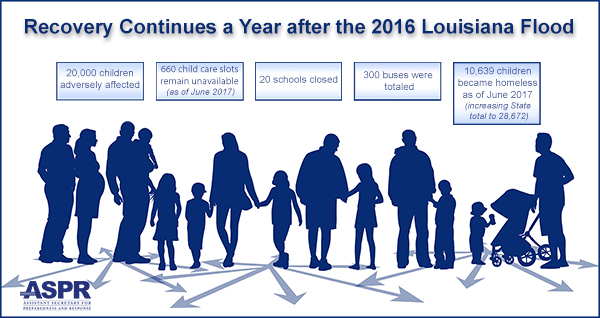Last year’s flooding in Louisiana ranked as the fourth worst disaster in U.S. history. Fifty-six of Louisiana’s 64 parishes were affected by major floods in 2016, and communities are still recovering with the help of an interagency federal response.
Child care centers and schools closed. The statistics related to children were staggering.

Abrupt closings of child care centers or changes to child care relationships can have negative consequences for children, parents or other caregivers, and providers. The child’s developmental and emotional supports are interrupted. Parents no longer have the sense of security that a routine child care center provides. Parent or caregiver hours of work may be disrupted or discontinued, causing financial hardships and possibly relocation.
The federal government acted by using an existing coordinating structure: Recovery Support Functions (RSFs). The RSFs describe six key functional areas of assistance in the National Disaster Recovery Framework (NDRF). In the wake of both disasters, all six Recovery Support Functions (RSFs) were activated, including the Health and Social Services RSF. Substantial data were gathered, analyzed, and evaluated, applying recovery core capability-specific expertise to identify recovery needs and issues as well as recovery-related effects that may exceed state and local capacity.
Just as the assessment and determination was being completed for the March floods, the August disaster struck, prompting the team to reassess its approach to recovery coordination. Early indications were that the issues of concern in the northern parishes were very similar to those in the more heavily damaged southern parishes multiplied by greater numbers of residents.
These findings were the basis for developing a unified Recovery Support Strategy (RSS) encompassing those communities affected by the March and August flooding events and directing the unified work of recovery in Louisiana. The Louisiana Floods RSS documents comprehensive strategies for identified issues and involves extensive coordination among federal, state, local, and community partners. The Health and Social Services section of the RSS identified multiple recovery areas, including the effects to children and families.
During response the Health and Social Services RSF Field Coordinator convened a federal inter-agency school task force to ensure federal agencies were aware of the data affecting children and youth and addressing identified needs accordingly.
The data the Task Force gathered informed the next steps that federal and state partners took, such as:
- FEMA’s Public Assistance Program prioritized installing temporary school facilities, and repairing and rebuilding existing schools and eligible child care facilities;
- USDA extended free and reduced lunches to all students in declared parishes;
- HHS Administration for Children and Families allowed grantees to postpone child care facility immunization requirements and increase the number of children per provider; and
- The Louisiana Department of Education issued waivers that allowed buses to operate past their 10-year cycle.
Over the next month, the Health and Social Services RSF will work with the Louisiana Department of Children and Family Services and five parishes to support the Children’s Disaster Recovery Task Forces so the needs of children and families are known in response and planned for in recovery.
A disaster may only last for a few days or weeks, but its effects may be felt for many years. With solid planning and good coordination, federal and state partners can work together to help communities recover.

